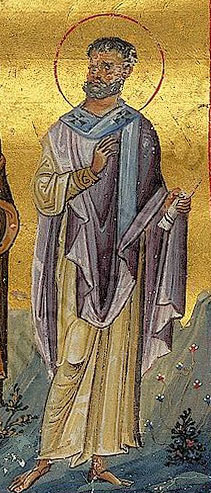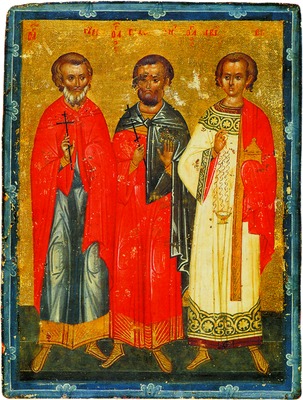
Agnes of Rome is a virgin martyr, venerated as a saint in the Catholic Church, Oriental Orthodox Church and the Eastern Orthodox Church, as well as the Anglican Communion and Lutheran Churches. She is one of several virgin martyrs commemorated by name in the Canon of the Mass, and one of many Christians martyred during the reign of the Roman emperor Diocletian.

Galerius Valerius Maximinus, born as Daza, was Roman emperor from 310 to 313. He became embroiled in the civil wars of the Tetrarchy between rival claimants for control of the empire, in which he was defeated by Licinius. A committed pagan, he engaged in one of the last persecutions of Christians, before issuing an edict of tolerance near his death.

Onuphrius lived as a hermit in the desert of Upper Egypt in the 4th or 5th centuries. He is venerated as Saint Onuphrius in both the Roman Catholic and Eastern Catholic churches, as Venerable Onuphrius in Eastern Orthodoxy, and as Saint Nofer the Anchorite in Oriental Orthodoxy.

Lecce is a city in southern Italy and former capital of the province of Lecce, with the second-highest population in the Apulia region. It is on the Salentine Peninsula, at the heel of the Italian Peninsula, and is over two thousand years old.

Saint Acacius, also known as Agathius of Byzantium, Achatius, or Agathonas to Christian tradition, was a Cappadocian Greek centurion of the imperial army, martyred around 304. A church existed in Constantinople associated with Acacius and possibly named after him: the Church of St Acacius.
Dorothea of Alexandria is venerated as a Christian virgin and saint. Her legend states that the Roman Emperor Maximinus Daia courted her, yet she rejected his suit in fidelity to Christianity and virginity, and fled Alexandria. She died in Arabia around 320.

Olivia of Palermo, Palermo, 448 – Tunis, 10 June 463, while according to another tradition she is supposed to have lived in the late 9th century AD in the Muslim Emirate of Sicily is a Christian virgin-martyr who was venerated as a local patron saint of Palermo, Sicily, since the Middle Ages, as well as in the Sicilian towns of Monte San Giuliano, Termini Imerese, Alcamo, Pettineo and Cefalù.

Onesiphorus was a Christian referred to in the New Testament letter of Second Timothy. According to the letter sent by St. Paul, Onesiphorus sought out Paul who was imprisoned at the time in Rome.

Saints Victor and Corona are two Christian martyrs. Victor was a Roman soldier who was tortured and killed; Corona was killed for comforting him. Corona is invoked as a patron of causes involving money; she was not historically associated with pandemics or disease, but has been invoked against the coronavirus pandemic.

Eurosia is the patron saint of Jaca, a city in the province of Huesca of northeastern Spain, in the Pyrenees, the centre of her cult.

Abibus of Edessa, also known as Abibus the New, Habib the Deacon or Saint Habibus the Martyr, was a 4th-century Syrian Christian deacon, confessor and martyr, who according to the Martyrdom of Habib the Deacon, was executed at Edessa by immolation under Roman Emperor Licinius. He is venerated as a saint by the Catholic, Eastern Orthodox and Oriental Orthodox Churches.

Calimerius was an early bishop of Milan. He is honoured as a Saint in the Catholic and Eastern Orthodox churches and his feast day is on July 31.

Chiaffredo is venerated as the patron saint of Saluzzo, Italy. Tradition considers him a member of the Theban Legion, but instead of being martyred with this legion at Agaunum, he escaped to Piedmont and was martyred there.

Phebronia of Nisibis, also known as Phebronia of Sebapte, was a nun at Nisibis. She suffered persecution under Diocletian, who offered her freedom if she renounced her faith and married his nephew, Lysimachus, who had been leaning towards conversion to Christianity. Febronia refused and was tortured, suffered mutilation and death. Lysimachus, witnessing her suffering, converted.

Exuperantius of Cingoli was a 5th-century bishop of Cingoli,, in the Marche region of Italy. He is recognised as a saint in the Catholic and Eastern Orthodox Churches. Tradition attributes numerous miracles to his intercession both during his life and after his death, including the cessation of an outbreak of plague. Little is known about him with certainty, although he may have come from Africa.

Saint Spyridon Church is a Serbian Orthodox church in Trieste, Italy.

The church of Sant'Ampelio is located on Cape Sant'Ampelio, at the end of the "Promenade Argentina" in Bordighera in Liguria, Italy. The church is part of the properties protected by the Superintendent of Ministry of Cultural Heritage and Activities and Tourism.
Saint Greca was a Christian woman who lived on Sardinia. According to tradition she was martyred during the Diocletianic Persecution. She is venerated as a saint by the Catholic Church.

The Sanctuary of Saint Anthony of Padua, also known as the Church of Saint Anthony of Padua is a Roman Catholic place of worship located in the city of Turin, Italy.
Elisabetta "Elisa" MartinezDML was an Italian Catholic nun and founder of the congregation of the Daughters of Saint Mary of Leuca. She was beatified on June 25, 2023 in Lecce.
















